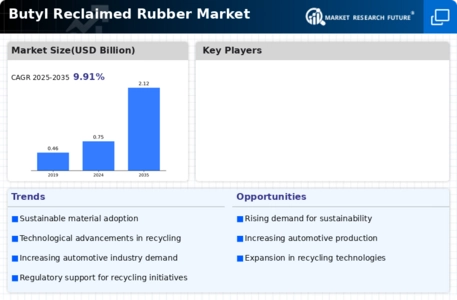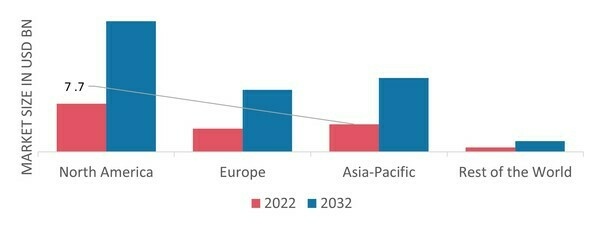Market Growth Projections
The Global Butyl Reclaimed Rubber Market Industry is poised for substantial growth, with projections indicating a market value of 0.75 USD Billion in 2024 and an anticipated increase to 2.12 USD Billion by 2035. This growth trajectory suggests a compound annual growth rate (CAGR) of 9.93% from 2025 to 2035. Such figures highlight the increasing adoption of reclaimed rubber across various applications, driven by sustainability initiatives and technological advancements in recycling processes. The market's expansion reflects a broader trend towards environmentally friendly materials, positioning reclaimed rubber as a key player in the future of manufacturing.
Increasing Demand for Sustainable Materials
The Global Butyl Reclaimed Rubber Market Industry is experiencing a surge in demand for sustainable materials, driven by heightened environmental awareness among consumers and manufacturers. As industries strive to reduce their carbon footprints, reclaimed rubber emerges as a viable alternative to virgin rubber. This shift is evident in various sectors, including automotive and construction, where companies are increasingly incorporating reclaimed rubber into their products. The market is projected to reach 0.75 USD Billion in 2024, reflecting a growing recognition of the benefits of using recycled materials. This trend not only supports sustainability goals but also aligns with regulatory frameworks promoting eco-friendly practices.
Regulatory Support for Recycling Initiatives
Government regulations promoting recycling initiatives are playing a crucial role in shaping the Global Butyl Reclaimed Rubber Market Industry. Many countries are implementing policies that encourage the use of recycled materials in manufacturing processes. For example, regulations mandating the recycling of tires have led to an increase in the availability of reclaimed rubber. This regulatory support not only fosters a favorable environment for the market but also incentivizes manufacturers to invest in reclaimed rubber production. As the industry evolves, it is likely that such policies will continue to drive growth, contributing to the projected market value of 2.12 USD Billion by 2035.
Growing Automotive Industry and Tire Production
The expansion of the automotive industry is a significant driver for the Global Butyl Reclaimed Rubber Market Industry. With the increasing production of vehicles, there is a corresponding rise in tire manufacturing, which is a primary application for butyl reclaimed rubber. The automotive sector is increasingly adopting reclaimed rubber to enhance tire performance while reducing costs. This trend is particularly evident in regions with robust automotive manufacturing bases. As the market continues to grow, the integration of reclaimed rubber in tire production is expected to bolster demand, further solidifying its role in the industry.
Rising Awareness of Circular Economy Principles
The concept of a circular economy is gaining traction globally, influencing the Global Butyl Reclaimed Rubber Market Industry. As businesses and consumers become more aware of the benefits of recycling and reusing materials, the demand for reclaimed rubber is likely to increase. This shift towards a circular economy not only minimizes waste but also promotes resource efficiency. Companies are beginning to recognize that incorporating reclaimed rubber into their products can enhance their sustainability profiles. This growing awareness is expected to drive market growth, as stakeholders seek to align their operations with circular economy principles.
Technological Advancements in Recycling Processes
Technological innovations in recycling processes are significantly influencing the Global Butyl Reclaimed Rubber Market Industry. Enhanced methods for reclaiming rubber from used tires and other sources have improved the quality and performance of reclaimed rubber. These advancements enable manufacturers to produce high-quality products that meet stringent industry standards. For instance, the development of advanced devulcanization techniques has made it possible to restore the properties of butyl rubber effectively. As a result, the market is expected to grow at a CAGR of 9.93% from 2025 to 2035, indicating a robust future driven by continuous improvements in recycling technologies.


